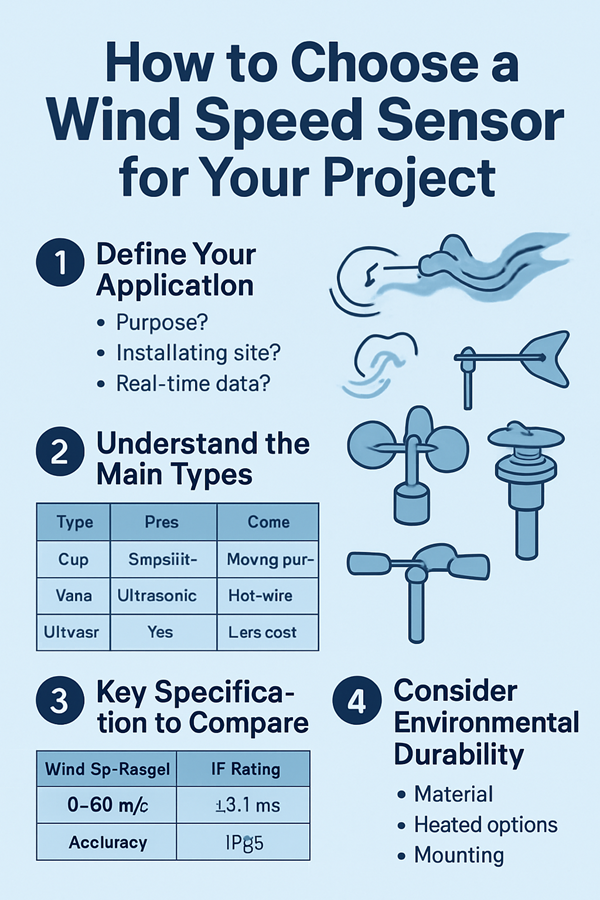Views: 0 Author: Site Editor Publish Time: 2025-08-07 Origin: Site

 Whether you’re building a DIY weather station, monitoring wind for agriculture, or setting up a smart energy system, choosing the right wind speed sensor—also known as an anemometer—can feel confusing. But don’t worry. In this beginner-friendly guide, we’ll explain the basics and help you pick the right wind velocity sensor for your project.
Whether you’re building a DIY weather station, monitoring wind for agriculture, or setting up a smart energy system, choosing the right wind speed sensor—also known as an anemometer—can feel confusing. But don’t worry. In this beginner-friendly guide, we’ll explain the basics and help you pick the right wind velocity sensor for your project.
A wind speed sensor, or anemometer, measures how fast the wind is blowing. These sensors are used in:
Weather stations;
Solar/wind power systems;
Agriculture and irrigation;
Building automation;
Drones and robotics.
Some advanced models, like ultrasonic wind sensors, also measure wind direction and don’t have moving parts—making them ideal for long-term outdoor use.
Let’s break down the 3 most common types of sensor wind speed devices:
| Sensor Type | Description | Pros | Cons |
|---|---|---|---|
| Cup Anemometer | Rotating cups spin faster as wind increases | Simple, affordable | Moving parts may wear out |
| Vane Anemometer | Small fan blade spins with wind | Measures speed & direction | Less accurate in low wind |
| Ultrasonic Wind Sensor | Uses sound waves to detect wind speed | High precision, no moving parts | Higher cost |
Tip: If you need a low-maintenance and highly accurate device, ultrasonic wind sensors are a great option.
Here are 5 important things to check before buying:
| Feature | What to Consider |
|---|---|
| Wind Speed Range | Make sure it covers your needs (e.g. 0–60 m/s) |
| Accuracy | Look for ±0.3 m/s or better |
| Temperature Range | Can it work in your local climate? |
| Output Type | Pulse, analog, RS485, or Modbus depending on your system |
| Durability | Choose waterproof (IP65+) and UV-resistant materials for outdoor use |
Depending on your system, you’ll need the right output signal:
Pulse or analog (0–5V) – Good for Arduino or Raspberry Pi
RS485 / Modbus – For industrial use or long cable distances
SDI-12 – For environmental data loggers
If you’re a beginner working on a small project, look for sensors labeled as “plug and play” or “compatible with Arduino.”
| Use Case | Suggested Sensor |
|---|---|
| Home weather station | Cup or vane anemometer |
| Smart farming | Ultrasonic wind sensor |
| Wind turbine monitoring | High-accuracy ultrasonic |
| IoT weather node | Small sensor with RS485 or pulse output |
| Budget | What You Get |
|---|---|
| <$30 | Basic wind speed sensor (cups or vane), good for learning |
| $35–$200 | Mid-level ultrasonic wind sensor, great for agriculture or remote monitoring |
| $300+ | High-end sensor with long life, better accuracy, and digital interface |
Double-check power supply requirements
Make sure the sensor is weatherproof
Confirm it works with your data logger or controller
Look at real reviews from similar users (agriculture, research, DIY)
Choosing the right anemometer or wind velocity sensor doesn’t have to be difficult. Start with your use case and environment, and then choose a sensor that offers the right balance of accuracy, durability, and ease of use.
If you’re just getting started, a basic cup sensor may be all you need. For more serious projects, an ultrasonic wind sensor offers greater precision and long-term reliability.
If you need help selecting a model? Let us know your project and we’ll suggest the best wind speed sensor for you!
Click here to send an inquiry.
content is empty!
| Product Name |
|---|
| Wind Speed Sensor – Accurate & Durable Outdoor Anemometer |
| Accurate Wind Monitoring Made Simple with the BGT-FSX1-T Wind Speed and Direction Sensor |
| Accurate Wind Monitoring BGT-FSX2(O) Integrated Wind Sensor |
| Desert Climate Wind Speed Sensor |
| Mini Low Power Consumption Ultrasonic Wind Speed Direction Sensor for Weather Station |
| High Precision Heating RS485 SDI12 Ultrasonic Anemometer Wind Speed and Direction Sensor for Weather Station |
| Meteorological WindMaster Sensor: Accurate Speed & Direction |
| Mini Ultrasonic Wind Speed And Wind Direction Sensor Weather Station |
| Accurate Marine Wind Measurement for Safer, Smarter Operations |